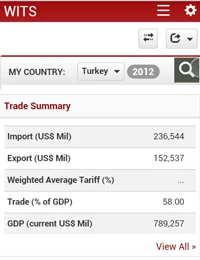Where can you find the top trading partners for your country? Where can you find the top products exported to and imported from Indonesia? Where can you find just about any type of trade data?
The answers to these questions (and more) are available at our recently revamped World Integrated Trade Solution (WITS) site: wits.worldbank.org. In previous versions of the site, users needed to login and query the data themselves. You still can. And many still do to conduct much more detailed and sophisticated research and analysis on trade. But if you want to quickly look up or browse trade statistics like total exports, tariffs applied, top export, and import partners, the data has been pre-calculated and made available as Open Data.
“Thanks to the data I found on WITS, I successfully completed my PhD. Really easy-to-use site and great upgrades.”
– User in India
The new site has a responsive design that works well on various screen sizes and mobile devices. Here are the top five features we hope you will enjoy:
- Easier navigation, speed and accessibility: The team focused on easier navigation, accessibility, speed, and data visualization. Users may now obtain data on a select country’s total exports, imports and trade by product groups such as minerals, fuels, and the like. For example, if you selected China on the home page, you’d quickly see the top five countries to which China exported in 2012:
Top five countries to which China exported in 2012To view the country names and trade values, please mouse over the above line graphs. Additionally, to see the list of countries and years for which trade summary statistics is available, browse our data availability page.
-
Mobile access and social sharing: The site works on mobile devices, including the interactive data visualizations. Browsed pages get stored locally, allowing users to continue browsing these pages even without an Internet connection. Users may also share pages on social media sites such as Facebook, Twitter, Google+, LinkedIn, Reddit, or good old fashioned email.
WITS can be viewed on a mobile phone or tablet
- Embeddable charts and tables: Let’s say while reviewing the various merchandise indicators, you come across a chart or table you would like to use. By clicking on this scissor image
, you can “clip” the chart/table using the embed code provided and drop it into your website or blog post as the below chart which shows South Africa’s exports by Product Groups to the World:
South Africa Exports in 2012 to the World by Product Groups - Access trade, tariff, and development indicators: For users wanting to dig deeper, we have added numerous trade, tariff, relevant development indicators, as well as relevant development indicators from the popular World Development Indicators (WDI). They include Country Growth, the Hirschman Herfindahl Market concentration index, number of export/import products, number of traded products, and much more. To view the complete list of trade indicators, visit our trade indicators metadata section.
Tariff indicators available by country include effectively applied simple and weighted average tariff, Most Favored Nation (MFN) simple and weighted average tariff, number of trade agreements, dutiable and duty free lines, and much more. To view the complete list of tariff indicators, visit our tariff indicators metadata section. In addition to existing merchandise and services trade indicators, as well as other development indicators such as GDP, GDP per capita, GNI per capita, and others. For the complete list of development indicators, go to the development indicator metadata section.
- Metadata and documentation: No site is complete without support materials. All indicators and countries have relevant metadata. All the metadata can be accessed from the metadata page and can be further narrowed or refined by selecting relevant tabs and dropdowns. The methodology used for trade indicators, Non-Tariff Measures (NTM) coding, and tariff cut simulation can be accessed in the methodology section. For users wanting to learn how to convert from one product nomenclature to another, say Harmonized System (HS) to Broad Economic Categories (BEC), please visit the Concordance section. You may also view the glossary page.
We hope you find the new WITS site useful, and you are able to find the data you need quickly and easily. For users who wish to perform their own customized queries, please register here and Login to the main WITS application. To share your comments and suggestions about the site, please type in your comments below or e-mail us at wits@worldbank.org.



Join the Conversation